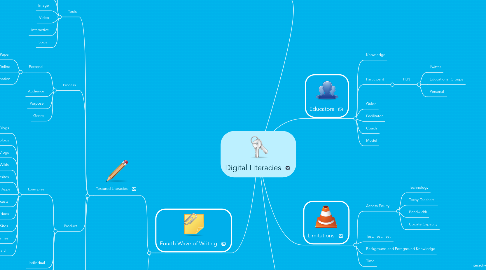
1. Fourth Wave of Writing
1.1. Textured Literacies
1.1.1. Tools
1.1.1.1. Text
1.1.1.2. Audio
1.1.1.3. Image
1.1.1.4. Video
1.1.1.5. Interactive
1.1.1.6. Social
1.1.2. Process
1.1.2.1. Personal
1.1.2.1.1. Traditional Paper
1.1.2.1.2. Online
1.1.2.1.3. Combination
1.1.2.2. Audience
1.1.2.3. Purpose
1.1.2.4. Genre
1.1.3. Product
1.1.3.1. Examples
1.1.3.1.1. Blogs
1.1.3.1.2. Glogs
1.1.3.1.3. Vlogs
1.1.3.1.4. Wikis
1.1.3.1.5. Websites
1.1.3.1.6. Collaborative Google Apps
1.1.3.1.7. Podcasts/Vodcasts
1.1.3.1.8. Videos
1.1.3.1.9. Social Sites
1.1.3.1.10. Games
1.1.3.1.11. Search / Research
1.1.3.2. Individual
1.1.3.3. Collaborative
1.1.3.4. Original
1.1.3.5. Remix
1.1.3.6. Portfolio
1.1.3.7. Global/Local Solutions
1.1.4. Content
1.1.4.1. Integrated Disciplines
1.1.4.2. Questions / Answers
1.1.4.3. Research Strategies
1.1.5. Digital Citizenship
1.2. Assessment
1.2.1. Portfolio
1.2.2. Authentic Works
1.2.3. Collaboration
1.2.3.1. Global
1.2.3.2. Local
1.2.4. Feedback
1.2.4.1. Self
1.2.4.2. Peers
1.2.4.3. Social Communities
1.2.4.4. Teacher
1.2.4.5. Badges
2. Mind Map Guide This mind map is incomplete, but it may guide us in answering a few of the questions we have discussed so far: How does teaching/learning change with this new focus? In what ways should we be developing a new writing model for teaching? Susan How do we integrate writing into the content areas? Janet, Marsha How do we empower both instructors and students with flexible and adaptable tools? Aaron How do we curate our work? Tellio How do we assess this writing model? Kevin, Maryellen How do promote "adjacent possibilities?" Tellio How do we help English Language Learners is to simultaneously develop their literacy skills as well as they acquisition of their second language? Servando How do we create digital equity? Sheri, Tellio
3. Educators
3.1. Knowledge
3.2. Participant
3.2.1. PLN
3.2.1.1. Twitter
3.2.1.2. Educational Groups
3.2.1.3. Personal
3.3. Guide
3.4. Facilitator
3.5. Coach
3.6. Model
4. Limitations
4.1. Access Equity
4.1.1. Technology
4.1.2. Techy Teachers
4.1.3. Bandwidth
4.1.4. Update Capacity
4.2. Test, Test, Test
4.3. Background and Foreground Knowledge
4.4. Time
5. Fourth Wave of Reading
5.1. Process Strategies
5.1.1. Interactive
5.1.2. Collaborative
5.1.3. Personal
5.1.4. Traditional
5.1.5. Technological
5.2. Integrated Disciplines
5.3. Forms
5.3.1. Audio
5.3.2. Video
5.3.3. Image
5.3.4. Text
5.4. Products
5.4.1. Online
5.4.2. Personal
5.4.3. Social
5.4.4. Collaborative

